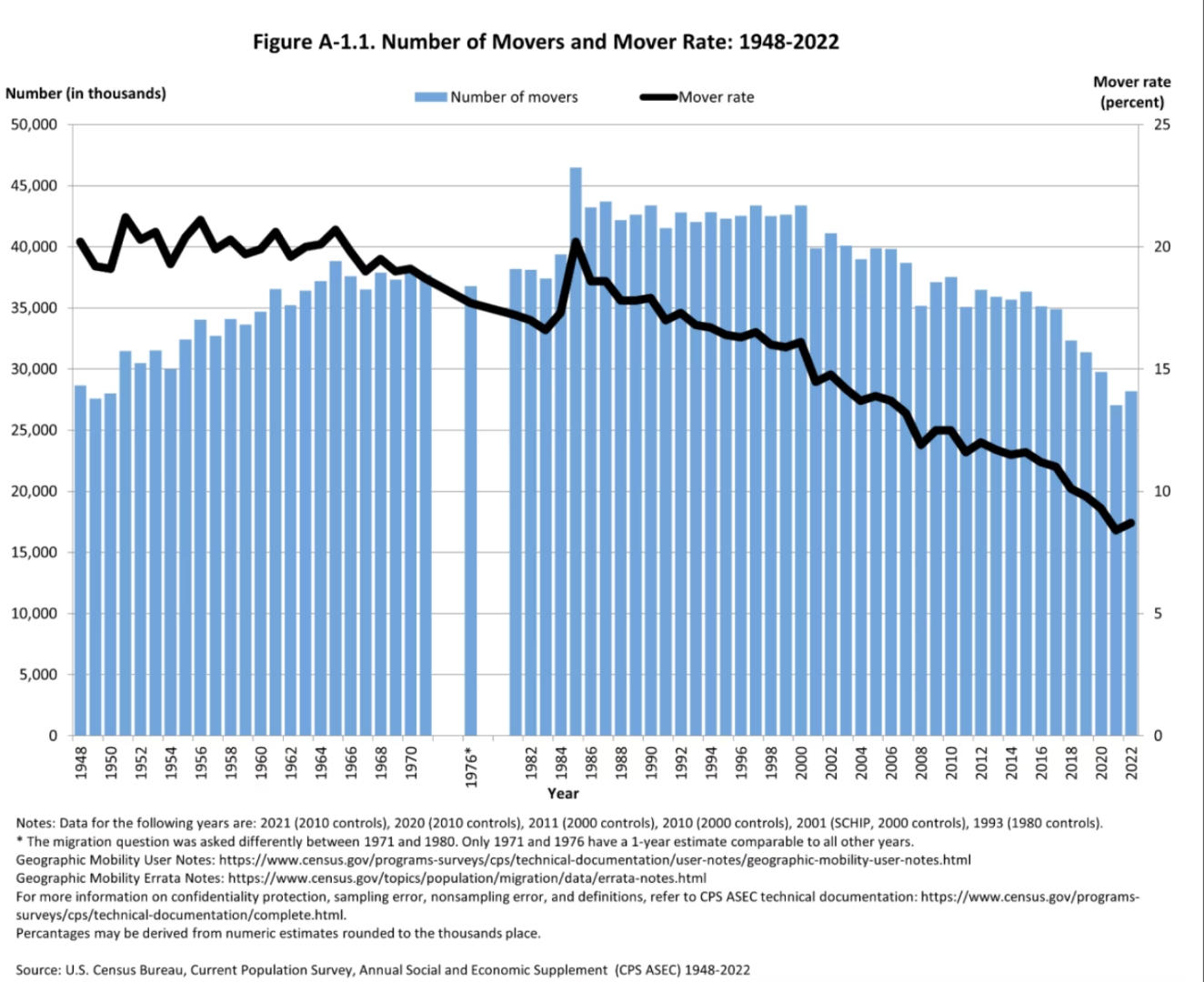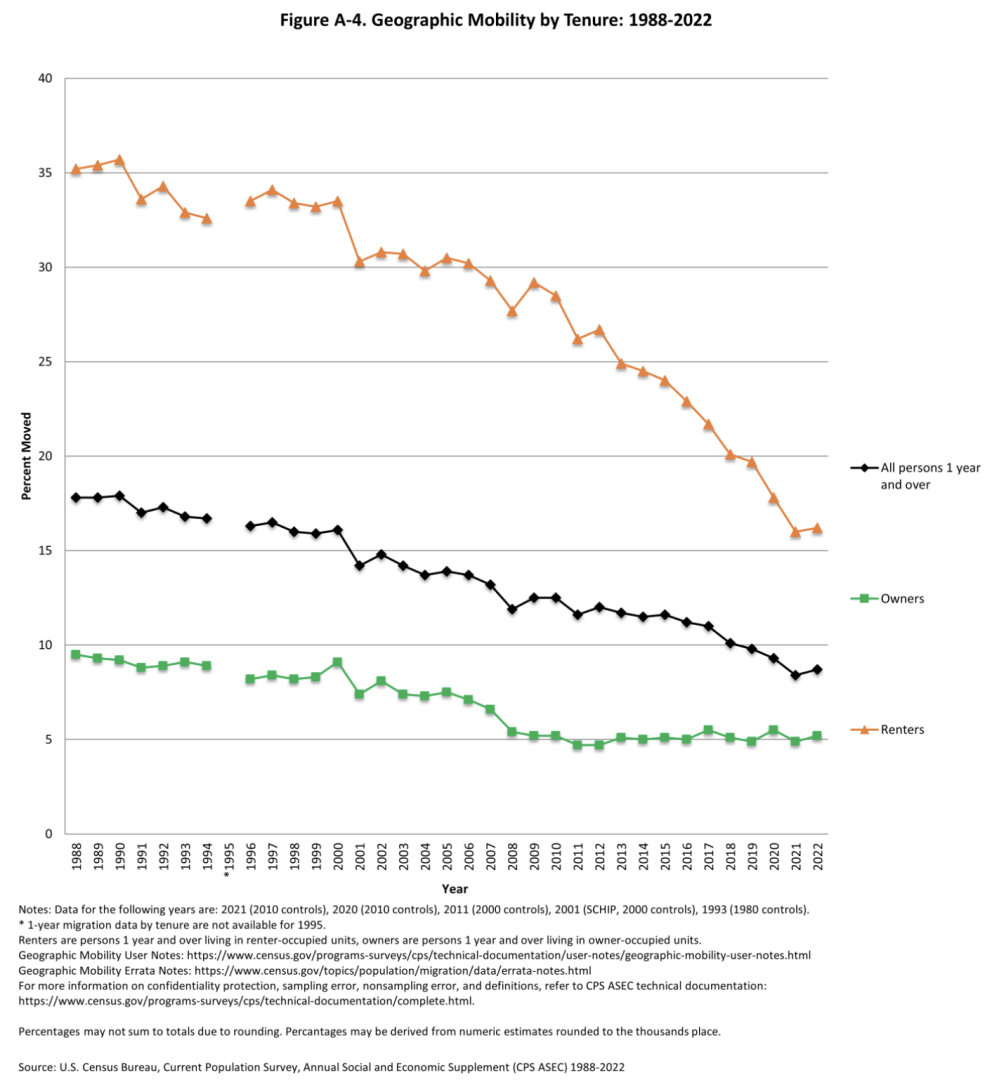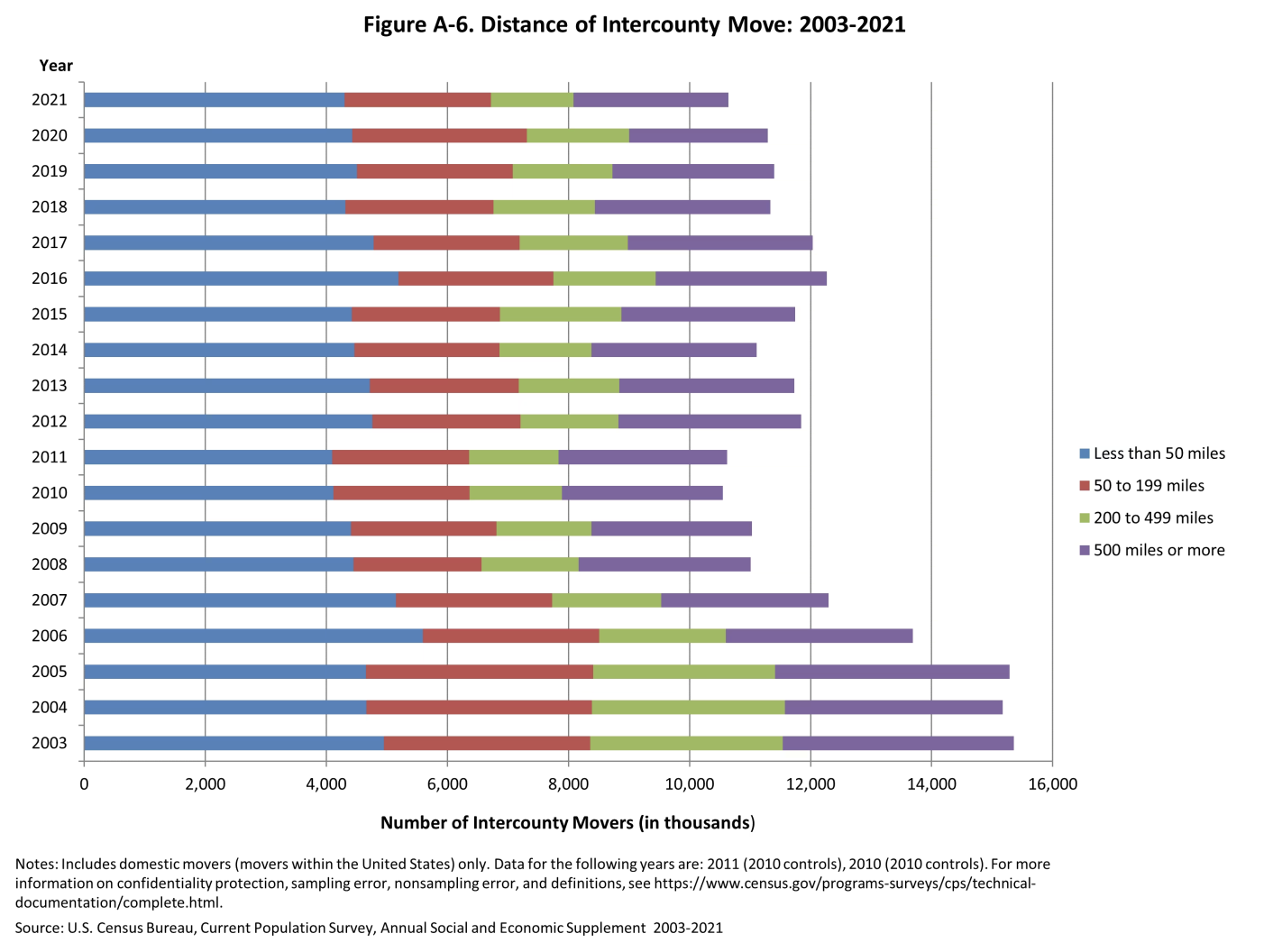Comments
- No comments found

One of the ways that the labor and housing markets are supposed to work involves geographic mobility.
Jobs are less available in one place than another? At least some workers should move for the new opportunities, which will help labor markets in both locations. Housing is cheaper in some areas than others? Then at least some people should be tempted to relocate. But Americans are moving less. The US Census Bureau has just published a series of graphs and data showing some trends (“CPS Historical Geographic Mobility/Migration Graphs,” August 10, 2023).
Here’s the overall picture. The “mover rate” on the right-hand axis looks at the share of households living in a different place than one year earlier. It used to be up around 20%; now it's under 10%. (The breaks in the blue lines happen because the surveys changed such that comparable data isn’t available for those years.) Notice that the decline in the mover rate is a long-run trend over four decades. It is axiomatic that you cannot plausibly explain a long-run trend with a one-time event, like the Great Recession of 2007-9 or the more recent pandemic. Something else is going on.

One standard explanation that could apply to at least some periods is that people feel “locked in” by owning a house, and are unwilling to move for that reason. But the rate of moving for people owning homes (green line) has declined only a little. Most of the shift is from renters (orange line) moving less.

Are there some clues for the shift in how far people move? This graph only shows moves that involve changing residence from one county to another. The number of short-range moves hasn’t changed much, but the number of longer range moves has declined since the early 2000s.

Although I know that the readers of these blog posts depend on me to provide easy answers to all social trends and public policy issues, I don’t have a great explanation here. Back in 2011, in an article in the Journal of Economic Perspectives (where I work as Managing Editor), Raven Molloy, Christopher L. Smith, and Abigail Wozniak wrote on this subject:
By most measures, internal migration in the United States is at a 30-year low. Migration rates have fallen for most distances, demographic and socioeconomic groups, and geographic areas. The widespread nature of the decrease suggests that the drop in mobility is not related to demographics, income, employment, labor force participation, or homeownership. Moreover, three consecutive decades of declining migration rates is historically unprecedented in the available data series. The downward trend appears to have begun around the 1980s, pointing to explanations that should be relevant to the entire period, rather than specific to the current recession and recovery—that is, the decline in migration is not a particular feature of the past five years, but has been relatively steady since the 1980s.
To me, the most plausible explanation is related to the run-up housing prices in a number of major urban areas over time. Imagine someone who looks at the high-paying jobs available in, say, New York City or Los Angeles or Chicago–and I’m thinking how much relatively low-skilled jobs can pay in those cities–and thinks about moving there. The additional cost that would be paid to rent or buy housing in those areas probably offsets any income gains.
Rebecca Diamond and Enrico Moretti tackle this question more explicitly in “Where is Standard of Living the Highest: Local Prices and the Geography of Consumption” (NBER Working Paper #29533, revised January 2023, also available in an ungated version here). The authors compare what your income can actually buy in different areas. They write (from the abstract):
We uncover vast geographical differences in material standard of living for a given income level. Low income residents in the most affordable commuting zone enjoy a level of consumption that is 95% higher than that of low income residents in the most expensive commuting zone. … We find that for college graduates, there is essentially no relationship between consumption and cost of living, suggesting that college graduates living in cities with high costs of living—including the most expensive coastal cities—enjoy a standard of living on average similar to college graduates with the same observable characteristics living in cities with low cost of living—including the least expensive Rust Belt cities. By contrast, we find a significant negative relationship between consumption and cost of living for high school graduates and high school drop-outs, indicating that expensive cities offer lower standard of living than more affordable cities. The differences are quantitatively large: High school drop-outs moving from the most to the least affordable commuting zone would experience a 18.5% decline in consumption.
In other words, a big reason that moving rate are down is that the economic incentive to move can be low: in places with higher wages, the higher cost of living offsets these gains, especially for low-income workers.
Timothy Taylor is an American economist. He is managing editor of the Journal of Economic Perspectives, a quarterly academic journal produced at Macalester College and published by the American Economic Association. Taylor received his Bachelor of Arts degree from Haverford College and a master's degree in economics from Stanford University. At Stanford, he was winner of the award for excellent teaching in a large class (more than 30 students) given by the Associated Students of Stanford University. At Minnesota, he was named a Distinguished Lecturer by the Department of Economics and voted Teacher of the Year by the master's degree students at the Hubert H. Humphrey Institute of Public Affairs. Taylor has been a guest speaker for groups of teachers of high school economics, visiting diplomats from eastern Europe, talk-radio shows, and community groups. From 1989 to 1997, Professor Taylor wrote an economics opinion column for the San Jose Mercury-News. He has published multiple lectures on economics through The Teaching Company. With Rudolph Penner and Isabel Sawhill, he is co-author of Updating America's Social Contract (2000), whose first chapter provided an early radical centrist perspective, "An Agenda for the Radical Middle". Taylor is also the author of The Instant Economist: Everything You Need to Know About How the Economy Works, published by the Penguin Group in 2012. The fourth edition of Taylor's Principles of Economics textbook was published by Textbook Media in 2017.
Leave your comments
Post comment as a guest